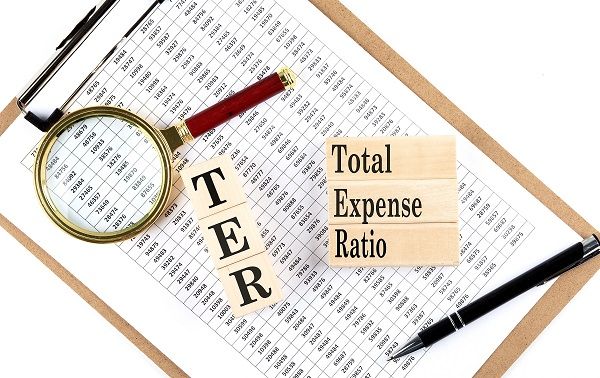Total Expense Ratio (TER) in Mutual Funds – Formula, Calculation and Impact

When you buy mutual fund units from a fund house or through a broker, you would notice that the total cost of the fund includes a fee in the form of total expense ratio or TER. This fee includes commission and operational charges that goes towards managing a fund. This adds up to the total fund cost. But does the TER of a mutual fund have any impact on your investments?
In this blog, we have explained TER meaning in mutual funds and why every investor should consider a fund’s TER before investing their money. Let’s dive in.
What is TER in Mutual Funds?
The Total Expense Ratio or TER in mutual funds is the fee that an Asset Management Company (AMC) imposes on investors to cover the cost incurred for running a mutual fund scheme. It is computed as a percentage of the overall Assets Under Management (AUM). Generally, the TER consists of a base TER, additional expenses as per Regulation 52(6A)(b) and 52(6A)(c), and Goods and Services Tax (GST).
TER Formula and Calculation
The formula for calculating expense ratio is as follows:
Expense Ratio= (Total costs that are borne by the mutual fund)/(Average assets under management)
Here,
Total costs borne by mutual fund = Costs incurred by the fund house such as expenses of distribution, marketing, legal/audit and fund manager’s fee
Average Assets under Management = Total value of the money of the investors kept in the fund
Let us understand the calculation with the help of an example. Suppose an equity fund has AUM of Rs.600 crore. and the expenses sum up to Rs.12 crore.
Therefore, the expense ratio formula would be Rs.12 crore/ Rs.600 crore = 2%
So, 2% will be charged as expense ratio.
Also Read
Major Components of TER in Mutual Funds
Here are some of the of the major components of total expense ratio that you should know of:
- Fund Management Fees: This constitutes a key component of the total expense ratio. In order to meet the cost of running an office, recruiting staff and managing funds, AMCs deduct this fee from the fund corpus. This is a fixed cost that is higher for active funds than passive funds.
- GST: For the fund management services provided by AMCs, an investor needs to pay GST. The current GST rate stands at 18%, making it a crucial cost component of mutual funds.
- Transfer Agent Fee: The transfer agent in mutual funds plays a similar role as the registrar of equity investment. A registrar takes care of all the unit holder services such as fresh investments, redemptions, account management, and corporate actions, including dividend payouts. In India, CAMS and Karvy are the principal transfer agents that hold such activities.
- Commissions and Brokerage: In mutual funds, there are two kinds of payable commissions – brokerage and statutory charges. These are payable due to the execution of transactions in debt and equity as part of routine portfolio management and commissions to the distributors who sell the products.
- Marketing and Operating Costs: The costs incurred on daily operations are the operating costs. It includes marketing expenses, such as the cost of advertising, branding, promotional activities and more. Note that if you invest in direct plans of mutual fund schemes, fund houses do not need to pay commission to the third-party agent (broker or distributor).
- Exit Load: Mutual fund houses charge a fee if investors redeem their investments before a certain period. It is usually 1% of the scheme’s NAV (Net Asset Value) if the investor withdraws before 12 months from investment. However, the actual amount varies from one fund house to another. Exit loads are commonly imposed to discourage investors from making premature withdrawals.
How is the TER Decided and Charged?
Asset Management Companies (AMC) charge the expense ratio based on the rules and regulations of the Securities and Exchange Board of India. The guidelines concerning TER in mutual funds are different for non-equity oriented and equity-oriented mutual fund schemes.
Here’s a tabular representation of the maximum TER that a fund house can charge for different types of mutual fund schemes:
| Assets Under Management | TER for equity-oriented funds | TER for non-equity oriented funds |
| On the first Rs. 500 crore | 2.25% | 2.00% |
| Next Rs. 250 crore | 2.00% | 1.75% |
| Next Rs. 1,250 crore | 1.75% | 1.50% |
| Next Rs. 3,000 crore | 1.60% | 1.35% |
| Next Rs. 5,000 crore | 1.50% | 1.25% |
| Next Rs. 40,000 crore | TER reduction of 0.05% for every increase of Rs. 5000 crore of daily net assets or part thereon | TER reduction of 0.05% for every increase of Rs. 5000 crore of daily net assets or part thereon |
| Above Rs. 50,000 crores | 1.05% | 0.80% |
Now let’s take a look at some charges that AMCs may levy over and above TER:
- Brokerage and transaction costs: Not exceeding 0.12% in case of cash market transactions and 0.05% in case of derivatives transactions
- Expenses not more than 0.30% of daily net assets contingent on specific minimum inflows from B30 (beyond the top 30 cities)
Besides these, note that a fund house can levy additional expenses of up to 0.20% of the daily net assets of a scheme. That said, such additional expenses are not applicable for close-ended schemes, ELSS funds or any scheme that does not have an exit load.
Impact of TER on mutual Fund Investments
The total expense ratio (TER) can have a significant impact on the returns of a mutual fund or exchange-traded fund (ETF) over time. In general, funds with higher TERs will have lower returns than similar funds with lower TERs, all else being equal. This is because the higher costs associated with the fund eat into the fund’s returns.
It is important to consider the TER when choosing a mutual fund or ETF. By selecting a fund with a lower TER, you may be able to maximize your returns over the long term. However, it is important to note that the TER is just one factor to consider when evaluating a fund, and it should not be the only criteria used to make investment decisions.
Why Do Fund Houses Keep Changing TER of Mutual Funds?
Market regulator SEBI (Securities Exchange Board of India) has put in place various guidelines with regard to the maximum expense ratio that a fund house can charge. Primarily, there are two reasons why fund houses keep changing their TER. Let us take a look at them:
1. Change in AUM leads to TER changes
The AUM of a mutual fund undergoes daily changes. But, it is not possible for a fund house to keep changing TER every day which is why TER changes, most commonly take place either quarterly or monthly.
2. TER is changed to remain competitive
Fund houses alter their TER strategies to remain competitive and attract more investors. Often, an AMC deliberately keeps its expense ratio lower than its peers and once it has attracted a large number of investors, it increases its TER.
SEBI Limitations on TER in Mutual Funds
The following chart illustrates the SEBI guideline for TERs in mutual funds:
| Asset Under Management Slabs | TER Limits for Equity Oriented Funds | TER Limits for Other Mutual Fund Schemes (excluding Index Funds, ETFs and Fund of Funds) |
| 0 – Rs. 500 crore | 2.25% | 2.00% |
| Rs. 500 crore – Rs. 750 crore | 2.00% | 1.75% |
| Rs. 750 crore – Rs. 2,000 crore | 1.75% | 1.50% |
| Rs. 2,000 crore – Rs. 5000 crore | 1.60% | 1.35% |
| Rs. 5,000 crore – Rs. 10,000 crore | 1.50% | 1.25% |
| Rs. 10,000 crore – Rs. 50,000 crore | TER decreases by 0.05% for each AUM increase of Rs. 5,000 crore or part thereof | TER decreases by 0.05% for each AUM increase of Rs. 5,000 crore or part thereof |
| Over Rs. 50,000 crore | 1.05% | 0.80% |
Apart from the expenses mentioned in the chart, the following expenses can be charged to the schemes:
- Extra charges permissible under Regulation 52(6A)(c), regarding exit load of a scheme.
- Expenses for inflows from retail investors under Regulation 52(6A)(b)
Also Read
Final Word
When choosing a mutual fund scheme, it is advised that you compare the expense ratio of different funds in the same category. That being said, considering the TER in mutual funds is not enough. Make sure to take into account other vital aspects, such as your financial goals, the experience of fund managers, and past returns of the scheme before investing.
Looking for mutual funds with low TER? Navi Mutual Fund features a wide range of low-cost mutual funds, including Navi Nifty 50, Navi Nifty Next 50, Navi NASDAQ 100 Fund of Fund, and more. Download the Navi app and start exploring low-cost mutual fund schemes across sectors and geographies.
FAQs
Ans: An index fund has a lower total expense ratio than equity funds or any other active funds as its management costs are low. Index funds are passively managed funds where fund managers simply track the underlying benchmark index. This is why they charge a lower management fee.
Ans: In the case of regular plans, fund houses pay out commissions to brokers and distributors who sell several products to their customers. To procure clients, one might need to pay upfront brokerage, and for retaining clients in the fund, there is a trail commission. However, in the case of direct plans, AMCs need not pay any distribution fees as no financial intermediary is involved. Due to this, the TER in mutual funds is lower for direct plans than regular plans.
Ans: Here’s the formula for net asset value (NAV):
NAV = [Overall Assets – (Total Liabilities + Total Expenses)] / Number of outstanding units
As you can see, the expenses of the fund are taken into account when computing NAV. Accordingly, the higher the expenses, the lower will be the fund’s NAV.
Ans: Debt funds generally yield lower returns than equity funds. For instance, let’s say you choose a debt fund with an expense ratio of 2%. Considering the average returns of a debt mutual fund scheme is between 6%-9%, you might consider choosing a fund with a minimum expense ratio for maximum returns.
Ans: AUM is the total value of assets held in a mutual fund scheme’s portfolio. As per SEBI regulations, AMCs can charge the maximum expense ratio based on the AUM. Therefore, if there is a change in a fund’s AUM, its expense ratio also changes.
Ans: As per SEBI regulations, mutual funds are required to disclose the TER for all schemes regularly on their website and the AMFI’s website. Moreover, the TER for equity funds should be 2.25%, and for debt funds, it should be 2% on the first 500 crore. Then one can consider the TER a good TER in mutual funds.
Ans: Mutual funds charge 2.5% for the first 100 crore of average weekly net assets. Further, for the next 300 crore the TER will be 2.25%, 2% for the next 300 crore and 1.75% for the balance AUM. This is considered the base total ratio in mutual funds.
Want to put your savings into action and kick-start your investment journey 💸 But don’t have time to do research? Invest now with Navi Nifty 50 Index Fund, sit back, and earn from the top 50 companies.
Disclaimer: Mutual Fund investments are subject to market risks, read all scheme-related documents carefully.
This article has been prepared on the basis of internal data, publicly available information and other sources believed to be reliable. The information contained in this article is for general purposes only and not a complete disclosure of every material fact. It should not be construed as investment advice to any party. The article does not warrant the completeness or accuracy of the information and disclaims all liabilities, losses and damages arising out of the use of this information. Readers shall be fully liable/responsible for any decision taken on the basis of this article.

10 Best Demat Accounts in India for Beginners in 2023
Creation of Demat accounts revolutionised the way trades were conducted at the stock exchanges. It... Read More »10 Best SIP Plans for 1000 Per Month in India 2023
Systematic Investment Plan (SIP) is an investment style or route with which you can invest a fixed ... Read More »How to Invest in Mutual Funds in India – Easy Steps
Mutual funds can be an excellent way to diversify your portfolio and gain exposure to a wide range ... Read More »20 Best Nifty 50 Index Funds in India to Invest in April 2023
What is the Nifty 50 Index Fund? Nifty 50 index funds are a type of passively-managed equi... Read More »Asset Management Company (AMC) – Types and Benefits
What is an Asset Management Company (AMC)? Asset Management Company or AMC is a financial ... Read More »10 Best Gold Mutual Funds to Invest in India (April 2023)
Gold Mutual Funds are funds that invest in gold and gold-related assets such as bullion, coin... Read More »20 Best Flexi Cap Mutual Funds to Invest in India 2023
Flexi-cap funds are mutual fund schemes that aim to invest in stocks of companies across market cap... Read More »Best SIP Plans for 15 years – Top 10 SIP Plans to Invest in India 2023
A systematic investment plan (SIP) could be a convenient mode or style of investing in mutual funds... Read More »10 Best SIP Plans for 1 year Investment in India 2023
There has been a massive surge in SIP or Systematic Investment Plan investors in recent years. As p... Read More »10 Best SIP Plan for 3 Years in India to Invest in 2023
SIP or Systematic Investment Plan helps bring investment discipline in an investor’s life. It’s... Read More »10 Best SIP Plan for 10 years India in 2023 – Returns and Performance
Ask any beginner mutual fund investor and most of them would tell you that their preferred mode of ... Read More »10 Best SIP Plans for 5 years in India to Invest in 2023
Systematic Investment Plan (SIP) could be an effective investment mode if you want to invest a fixe... Read More »Top 10 Chit Fund Schemes in India in 2023
Chit funds are one of the most popular return-generating saving schemes in India. It is a financial... Read More »10 Best Gold ETFs in India to Invest in April 2023
Gold ETFs or Gold Exchange Traded Funds are passively managed funds that track the price of physica... Read More »10 Best Demat Accounts in India for Beginners in 2023
Creation of Demat accounts revolutionised the way trades were conducted at the stock exchanges. It... Read More »20 Best Index Funds to Invest in India in April 2023
What is an Index Fund? An index fund is a type of mutual fund or exchange-traded fund (ETF) that... Read More »Best Arbitrage Mutual Funds to Invest in India in April 2023
Arbitrage funds are hybrid mutual fund schemes that aim to make low-risk profits by buying and sell... Read More »10 Best SIP Plans in India to Invest in April 2023
What is SIP? SIP or Systematic Investment Plan is a method of investing a fixed amount in ... Read More »10 Best Corporate Bond Funds in India to Invest in April 2023
Corporate bond funds are debt funds that invest at least 80% of the investment corpus in companies ... Read More »10 Best Bank for Savings Account in India [Highest Interest Rate 2023]
Savings account is a type of financial instrument offered by several banks. It lets you safely depo... Read More »

































